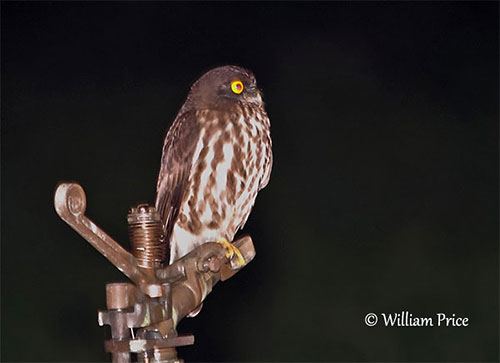
Male and female are similar.
The juvenile resembles adult but it has fluffy plumage, and the underparts are less streaked.
The chick has dense white down on the pink skin.
SUBSPECIES AND RANGE:
The Northern Boobook has three subspecies.
N.j. japonica (described above) is found in South Korea and Japan.
N.j. florensis occurs in SE Siberia (Ussuriland and Sakhalin Island), N and C China to North Korea. It winters S to Greater and Lesser Sundas.
This race is larger and paler than nominate.
N.j. totogo is found on Ryukyu Islands, Taiwan and Lanyu. It is sedentary.
This race is smaller with slightly shorter wings.
Depending on the authors, the race “totogo” is sometimes considered as a separate species named Ryukyu Boobook (Ninox totogo).
HABITAT:
The Northern Boobook frequents a variety of forest types such as lowland deciduous forests with tall trees, evergreen and coniferous forests, plantations, wooded parks and gardens, and also mangroves and swamps.
The species occurs from sea-level up to 1,700 metres of elevation.
CALLS AND SONGS: SOUNDS BY XENO-CANTO
The usual calls of the Northern Boobook are described as a sharp, nasal “heeoo”, a quiet, rolling “kerrrr” resembling a cat purring, and also a cat-like “meew”.
The song is pleasant and almost musical, not a loud sound but it can be heard at a distance. The bird utters 2-3 short, hollow “woop” notes at the same pitch with audible gap between the notes. These sounds are uttered in series with pauses between them. The breeding adults produce a series of deep “ho-ho, ho-ho, ho-ho, ho-ho, ho-ho, ho-ho, ho-ho”.
BEHAVIOUR IN THE WILD:
The Northern Boobook feeds primarily on invertebrates in summer such as large butterflies and various other flying insects. But crabs, lizards, amphibians, small birds and small rodents (including bats) are also part of its diet.
It is nocturnal, hunting from perch in clearings, at forest edges or in cultivated fields. The prey are caught on the ground or in the foliage, and insects are caught in mid-air.
During the day, the owl roosts among the dense vegetation.
At the beginning of the breeding season, the male sings prior to pair formation. During this period, the mates are observed moving around together and singing more frequently. This behaviour occurs during the period of copulation.
This species is a cavity-nester.
The migratory races spend the winter on the Greater and Lesser Sundas, and some also in E China.
This species is vagrant in Alaska.
The members of genus Ninox are amongst the more agile fliers. They fly through the trees at high speed without touching the branches. They perform sharp turns and almost vertical rises and falls.
REPRODUCTION OF THIS SPECIES:
On Taiwan, the egg-laying takes place from mid-March through April.
The Northern Boobook nests in natural cavity, often a hole in large tree, about 4-9 metres above the ground.
The female lays 3-4 white eggs and incubates during 25-31 days. She is usually fed by the male during this period.
At hatching, the chicks have dense white down. They are fed by both parents. They remain at nest about 24-26 days, and fledge in May.
PROTECTION / THREATS / STATUS:
The Northern Boobook is usually common to uncommon, depending on the range. It is the most common breeding owl in Japan.
The population is suspected to be stable and declines are not reported.
The species is not globally threatened, and the Northern Boobook is currently evaluated as Least Concern.
Fr: Ninoxe boréale
Ang: Northern Boobook
All: Nördlicher-Boobookkauz
Esp: Nínox Japonés
Ita: Gufastore settentrionale
Nd: Noord-Aziatische Valkuil
Sd: nordlig spökuggla
Photographer:
William Price
PBase-tereksandpiper & Flickr William Price
Text by Nicole Bouglouan
Sources:
HANDBOOK OF THE BIRDS OF THE WORLD Vol 5 by Josep del Hoyo-Andrew Elliott-Jordi Sargatal - Lynx Edicions - ISBN: 8487334253
OWLS OF THE WORLD – By Claus König, Friedhelm Weick and Jan-Hendrik Becking - IBSN 978-0-7136-6548-2
Owls of the World - A Photographic Guide: Second Edition – By Heimo Mikkola – Editeur: A&C Black, 2014 – ISBN: 147290592X, 9781472905925
Territorial behaviour of Northern Boobook Ninox japonica, on Calayan Island, northern Philippines
South Dakota Birds and Birding – (Terry L. Sohl)
Wikipedia, the free encyclopaedia
Northern Boobook
Ninox japonica
Strigiformes Order – Strigidae Family
INTRODUCTION:
The Northern Boobook was formerly a subspecies of the Brown Hawk-Owl (N. scutulata), but it is now a full species with three subspecies. It is endemic to E and S Asia.
This species is found in E Russia, North Korea, South Korea, N and C China, Taiwan and Japan. It frequents deciduous forests, conifer and mixed woodlands, and wooded parks and gardens, from sea-level up to 1,700 metres of elevation.
The Northern Boobook typically feeds on invertebrates, amphibians, small birds and rodents (including bats) caught at night from perches. It nests in natural cavities, usually a hole in large tree.
The Northern Boobook is common to uncommon, depending on the range. But currently, the species is not globally threatened.
DESCRIPTION OF THE BIRD:
Biometrics:
Length: 31-33 cm
Wingspan: 66-70 cm
Weight: 168-250 g
The Northern Boobook is a medium-sized owl.
The upperparts are dark brown with some white markings on scapulars. The tail is brown with broad, dark bars. The wings are long, giving the bird a hawk-like appearance.
The underparts are whitish with conspicuous, broad, longitudinal brown streaks.
Head and neck are mostly greyish-brown. On the head, the ear-tufts and the facial disk are absent, but we can see a white patch between the eyes.
The bill is blackish with dull greenish cere. The eyes are golden yellow. The tarsi are sparsely feathered. The feet are yellowish.
